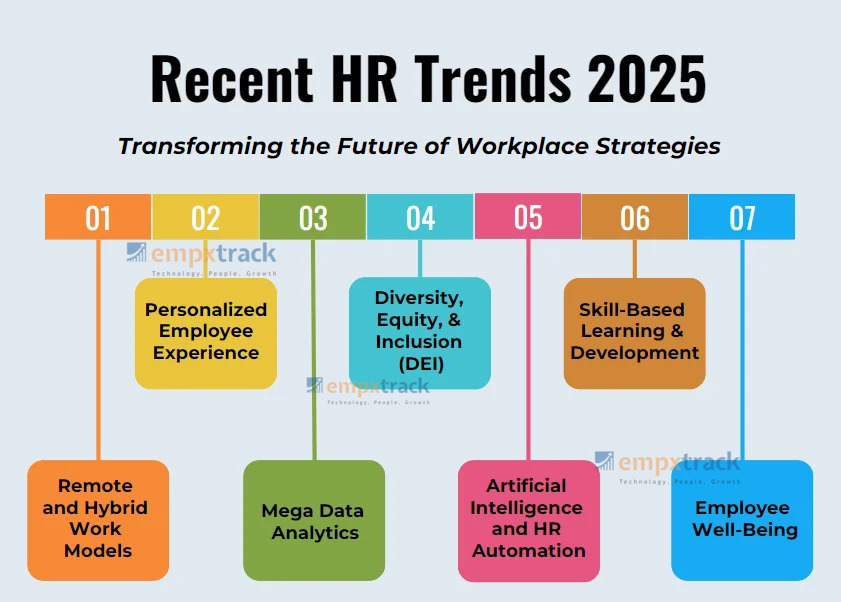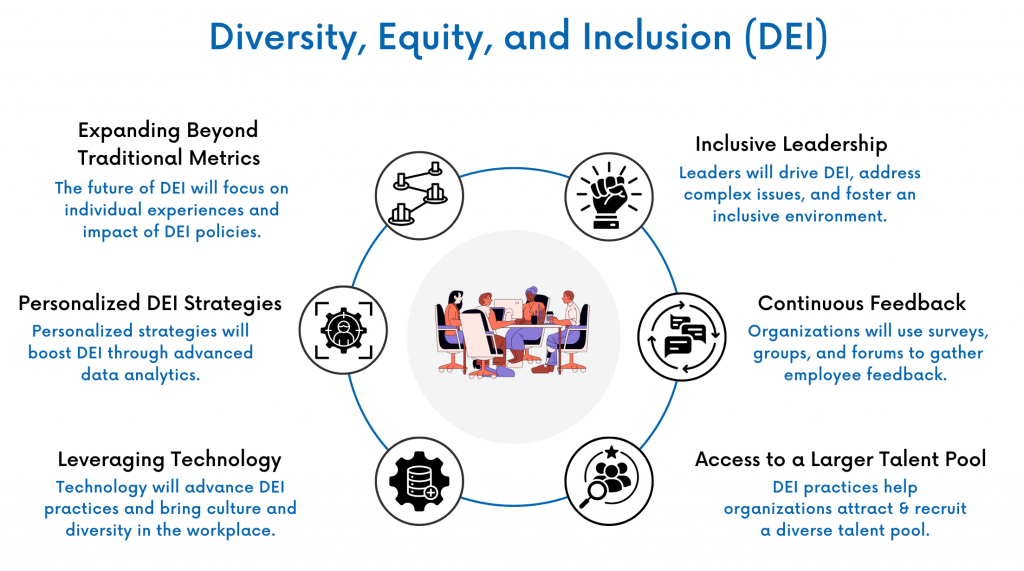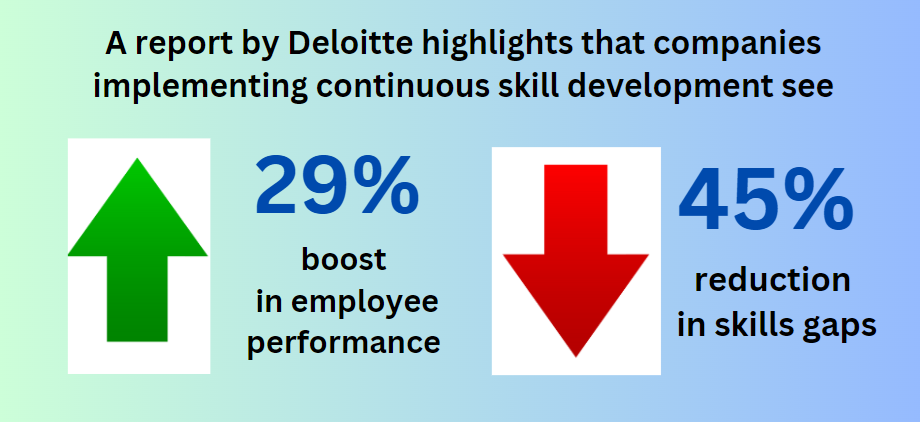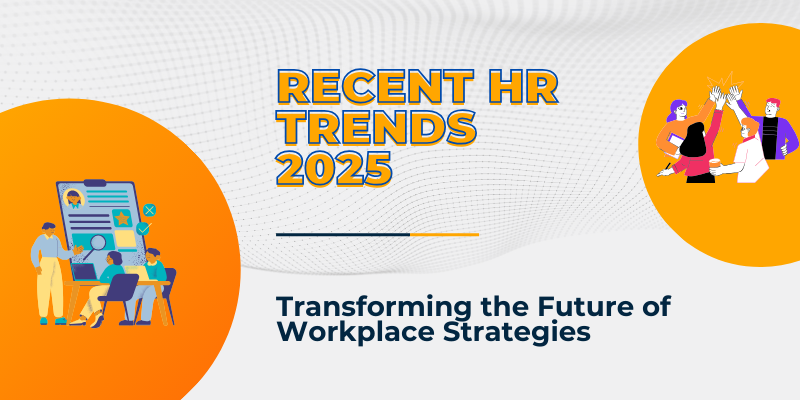Human resources trends shape how companies meet employee needs. They also enhance business value and align various functions with market demands. Therefore, understanding how the recent HR trends 2025 will change the future of the workplace is crucial.
Explore the changing HR landscape. Moreover, see how these new trends in HR will impact human resources strategies and practices in 2025 and beyond.
Latest Update – HR Trends 2026: What’s Next for Employees and Employers are also out, and you may read them to know what the future of HR may look like.
Consider a workplace where:
- » artificial intelligence doesn’t just support employees but collaborates with them
- » flexibility is no longer just a perk, but it’s a key aspect of the workplace culture
- » each employee’s experience is tailored, from their career path to daily interactions
Discover how these recent trends in HR will tackle tomorrow’s challenges. Subsequently, they will help you thrive in the dynamic landscape of 2025.
Table of Contents
- 1. List of Emerging Top HR Trends in 2025
- 2. Remote and Hybrid Work Models Set to Thrive in 2025
- 3. Personalized Employee Experience for Better Outcomes
- 4. Mega Data Analytics for Better People Management Decisions
- 5. Diversity, Equity, and Inclusion (DEI) – Shaping the Future Workplace
- 6. Artificial Intelligence and HR Automation
- 7. Skill-Based Learning and Development for a Competent Workforce
- 8. Conclusion
- 9. Frequently Asked Questions
List of Emerging Top HR Trends in 2025

Remote and Hybrid Work Models Set to Thrive in 2025
As we approach the next year, remote and hybrid work models will remain one of the prominent HR trends for 2025.
| A report from Gartner reveals that 71% of organizations are planning to maintain or expand their remote and hybrid work models. Thus, reflecting a strong shift toward flexible work arrangements. This trend highlights the growing use of these work models in the modern workforce. |
Flexibility and Satisfaction
Remote and hybrid models offer employees the flexibility to effectively manage their work-life balance, thus leading to increased job satisfaction.
According to Forbes, 77% of remote workers report higher productivity and better work-life balance compared to their in-office counterparts.
Technology and Integration
Advancements in technology will continue to support these work models. Tools like Zoom, Microsoft Teams, Slack, and Empxtrack will become crucial for collaboration and communication. Moreover, they will help manage people-related processes.
Besides, IDC predicts that global spending on collaboration software will exceed $25 billion by 2025. This further highlights the increasing investment in remote work technology. This would also include investments in HR technology as well.
Future Workspaces
Office spaces will evolve to support hybrid work environments. Companies will hence invest in flexible office designs that accommodate both in-office and remote employees. This will thus create collaborative hubs rather than traditional desks.
Personalized Employee Experience for Better Outcomes
| Companies with highly personalized employee experiences see a 30% increase in employee engagement and a 20% boost in overall productivity. |
Employee experience will be elevated through personalized, automated solutions. In the year ahead, AI-driven platforms will provide tailored learning and development opportunities. These would be based on individual career paths and performance data. Virtual HR assistants will additionally offer instant support for routine queries, thus freeing up HR teams to address more complex employee needs.
In 2025, personalized employee experience trends will become more important than ever. Organizations are moving beyond one-size-fits-all approaches. In addition, they are tailoring experiences to individual needs and preferences. Moreover, advanced HR technologies are driving this change. They use data-driven insights to offer customized career development plans, wellness programs, and work environments.
Mega Data Analytics for Better People Management Decisions
Another HR trend shaping the future of HR is mega data analytics. This will significantly influence HR by offering data driven insights into workforce trends and employee behavior. Predictive analytics in HR will foresee and address issues like turnover risks and skills gaps.
Here are some key ways in which data analytics can enhance the effectiveness of HR practices:
- Predictive Hiring: Data analytics will enable HR to forecast future hiring needs by analyzing workforce trends and patterns. Thus, helping in proactively managing talent acquisition and reducing time-to-hire.
- Enhanced Employee Engagement: Analyzing employee feedback and engagement metrics will help HR identify areas for improvement. This will subsequently boost satisfaction and retention.
- Personalized Learning and Development: The use of analytics will enable organizations to create customized training programs. These will in turn cater to each employee’s performance and career goals. This will consequently ensure more effective upskilling and reskilling.
- Optimized Workforce Planning: Mega data in HR will help in optimizing staffing levels and resource allocation and improving productivity. Additionally, workforce management tools will play a significant role in optimizing employee scheduling and streamlining HR operations.
- Improved Diversity and Inclusion: Analytics can track diversity metrics and check the effectiveness of inclusion programs. This will hence foster a more diverse and equitable workplace.
- Enhanced Performance Management: Real-time performance data will enable accurate assessments. They will also enable timely feedback and targeted development plans.
- Predictive Analytics for Retention: By analyzing turnover data and identifying risk factors, HR can thus implement retention strategies. This will prevent high attrition.
Diversity, Equity, and Inclusion (DEI) – Shaping the Future Workplace

In the coming year, the focus of the new human resource management trends will remain on embracing a deeper understanding of inclusivity within organizational cultures.
Expanding Beyond Traditional Metrics
The future of DEI will emphasize qualitative aspects like individual employee experiences and the impact of DEI policies. Organizations will moreover adopt more sophisticated methods. Furthermore, they will measure their initiatives on a truly inclusive workplace culture.
Personalized DEI Strategies
The implementation of personalized strategies will strengthen DEI efforts. Additionally, advanced data analytics will provide insights into diverse employee experiences. As a result, this will enable tailored DEI initiatives. These initiatives will address challenges like unconscious bias and accessibility. Thus, they will foster a more supportive and equitable workplace.
Leveraging Technology
Technology will definitely play a significant role in advancing DEI practices. It will additionally bring culture and diversity to the workplace. AI and machine learning will identify and mitigate biases in recruitment, performance evaluations, and promotions. Virtual and augmented reality will enhance DEI training. Moreover, they will provide immersive experiences that build empathy and understanding.
Inclusive Leadership
Leaders will be equipped to drive DEI initiatives. They will tackle complex issues, and foster an environment where everyone feels included and valued.
Continuous Feedback
Organizations will use regular surveys, focus groups, and open forums to gather employee feedback. This will help them improve DEI strategies.
Access to a Larger Talent Pool
DEI practices help organizations attract a diverse candidate base. they find the best fit for job roles. Additionally, this approach overcomes geographical and socio-economic barriers. Therefore, enabling organizations to hire talent from any location and background.
Artificial Intelligence and HR Automation
As we move into 2025, artificial intelligence is set to redefine the landscape of human resources. AI-driven automation is transforming HR practices. It is enhancing efficiency and thus reshaping how organizations manage their workforce.
AI in Recruitment and Talent Optimization
AI will streamline recruitment by automating candidate sourcing, screening, and initial virtual assessments. As a result, it will reduce hiring time and bias. Predictive analytics will also refine talent management. This will in turn help identify future leaders and customize development plans for individual needs.
HR Automation to Enhance Employee Experience and Streamline HR Processes
Artificial intelligence will personalize employee interactions. For example, it will offer real-time feedback, career insights, and support through chatbots. As a result, engagement will improve and HR’s administrative load will decrease. Meanwhile, tasks like payroll, benefits management, and compliance will become more automated. Thus, human intervention will be reduced.
Green HRM: Advancing Sustainability
Green HR promotes efficient use of resources and environmental sustainability through HR policies. Additionally, AI enhances these efforts. Hence, as companies shift towards eco-friendly practices, Green HRM plays a key role in merging corporate sustainability with HR functions.
Green HRM will use AI to minimize carbon footprints, promote paperless processes, and implement energy-efficient practices. Thus, adopting green HR practices will hence become a key focus area in the coming years.
Skill-Based Learning and Development for a Competent Workforce
Skill enhancement is not just one of the human resources trends. It will remain at the forefront of HR strategies. This is be because, it will be driven by the rapid pace of technological advancement and also evolving industry demands.

As part of the new HR trends, employers will continue to invest in employee reskilling and upskilling initiatives. This investment will focus on personalized employee training programs, thus equipping them with the necessary skills to adapt to new job requirements.
Aligning training programs with strategic goals helps companies. In addition, it ensures they can navigate industry trends and the modern business landscape effectively.
Employee Well-Being and Emerging Practices as a Recent HR Trend in 2025
The focus on well-being continues to intensify with new emerging practices.
New Trends in Employee Well-being
Mental Health Tech: In 2025, mental health technology is set to become a cornerstone of employee well-being programs. Advanced mental health apps and platforms help reduce workplace issues. They also empower employees to manage their well-being thus, fostering a supportive environment.
The Metaverse and Well-Being: The metaverse is transforming employee well-being with virtual experiences. Furthermore, these experiences enhance mental health and team cohesion. By integrating metaverse tools into well-being programs, companies can bridge the gap between remote work and social interaction. As a result, they foster a healthier workforce.
How to Maintain Employee Well-Being in the Hybrid Workplace?
- Virtual Wellness: Virtual fitness, online mindfulness, and teletherapy. Thus it ensures all employees, regardless of location, have access to wellness resources.
- Constant Connectivity: Constant connectivity through video conferencing and instant messaging helps remote employees feel less isolated. Consequently, it fosters social connections and maintains community.
- Ergonomic Home Office Support: Ergonomic home office support improves comfort and reduces injury risk. Therefore, investing in such support enhances the overall well-being of remote workers. Companies are planning virtual workspaces for 2025.
- Flexible Work Option: Flexible hours and remote work are replacing rigid 9-to-5 schedules. Hence, improving work-life balance, reducing stress, and enhancing job satisfaction.
By embracing these latest HR trends, organizations can create a more supportive, connected, and healthy work environment for employees.
Conclusion
The HR landscape will change by 2025. Clearly, innovation and adaptability will be crucial.
The integration of automation is set to revolutionize HR functions. It will thus free up valuable time for strategic initiatives. Personalized employee experiences will become the cornerstone of effective HR strategies. Remote and hybrid work models will continue to reshape traditional work environments. HR data analytics will further play a crucial role in providing actionable insights to optimize performance. This will enhance employee well-being, and make informed decisions.
By embracing these human resource trends, organizations can create more dynamic, inclusive, and efficient workplaces. These will that not only meet the demands of the modern workforce but also drive long-term success. In summary, the recent HR trends 2025 reflect a shift towards a more strategic, data-driven, and employee-centric approach. Organizations that leverage these advancements will thrive in the competitive business environment.
Liked what you read? Let’s take it to the next level!
Frequently Asked Questions
Q1. | What are future trends in HR for 2025? |
| Ans. | As we look towards 2025, the future of HR is set to be defined by innovative new trends in HR. These will in turn reshape how organizations manage and engage their workforce. Some of the latest trends in HR are as follows:
|
Q2. | What are the latest HR technology trends? |
| Ans. | The emerging trends in hr technology are based on transforming how organizations manage their workforce. Here are some key developments:
|
Q3. | Which are the best employee experience platforms? |
| Ans. | The best employee experience platforms are those that comprehensively manage all aspects of employee-related processes. These range from managing salary records to leave and attendance. They are user-friendly, personalized, mobile accessible and ensure data security and privacy. Empxtrack is a notable example of such a platform. It provides a robust suite of features that streamline HR operations. It moreover enhances employee engagement and supports effective management of various HR functions. |
Q4. | What is the future of HR in the next 5 years? |
| Ans. | In the next five years, the future of HR will focus more on leveraging technology to enhance recruitment, streamline processes, and improve employee engagement. HR professionals will increasingly use data analytics to make informed decisions and personalize employee experiences. There will be a continued emphasis on fostering a positive workplace culture and supporting employee development. Thus, adapting to these changes will be crucial for organizations, aligning with recent HR trends 2025. |




This blog offers a compelling look at the HR trends shaping the future of workplace strategies. Embracing innovation, flexibility, and technology will empower businesses to adapt and thrive in 2025 and beyond.
Thank you. Embracing these trends is essential.
Well-structured and insightful article. It perfectly captures how technology is transforming traditional HR practices. Automation is definitely a game-changer, making processes faster, smarter, and more employee-centric.
Absolutely! Automation is reshaping HR, and We’r glad the article captured that well for you.
The blog presents an exciting and optimistic view of the upcoming HR trends for 2025. It not only highlights the transformative impact of personalized employee experiences, remote and hybrid work models, mega data analytics, diversity, equity, and inclusion, artificial intelligence, HR automation, and skill-based learning and development, but also underscores how these trends will elevate the workplace environment and employee well-being. The use of compelling statistics, industry insights, and future projections instills confidence in the potential for positive change and growth within organizations.
Overall, the blog inspires a sense of enthusiasm and forward-thinking optimism about the future of HR practices and strategies. Thanks for sharing.
Thank you Andy for your thoughtful comment.